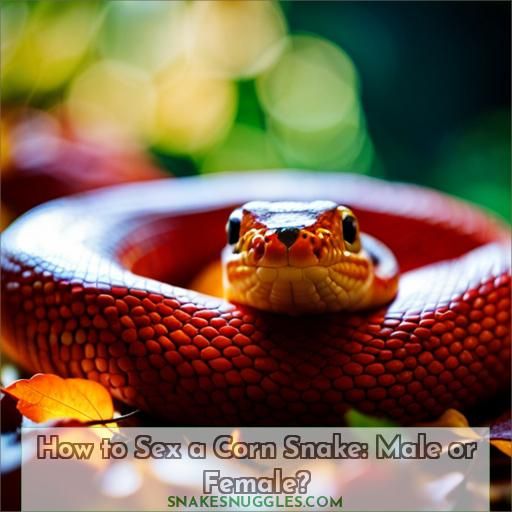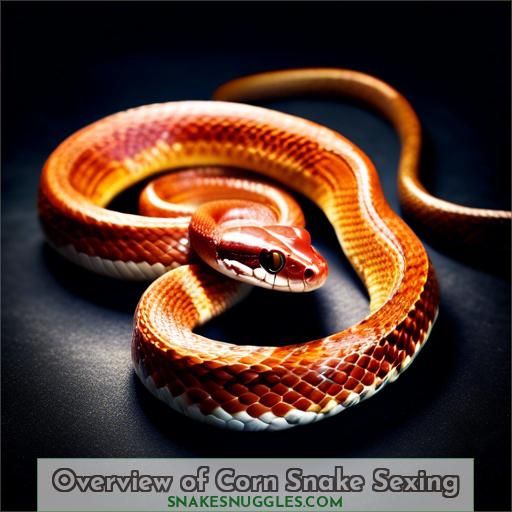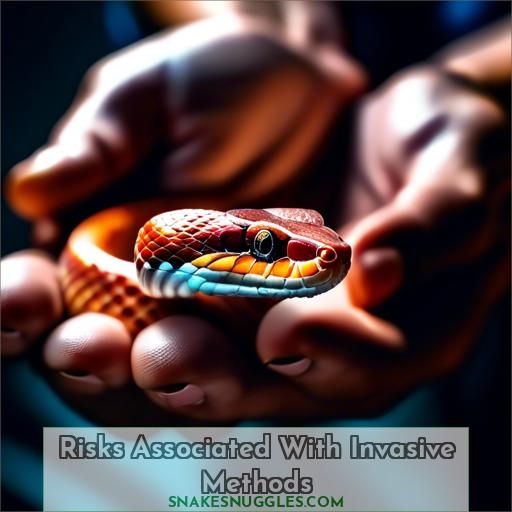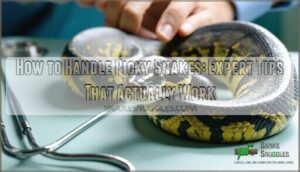This site is supported by our readers. We may earn a commission, at no cost to you, if you purchase through links.
 Accurately sexing your corn snake is crucial for proper care and breeding.
Accurately sexing your corn snake is crucial for proper care and breeding.
Discover safe, reliable techniques like visual inspection, probing, and popping hemipenes.
Explore potential risks of invasive methods and ethical alternatives such as veterinary exams or observing shed skins.
This guide empowers you with knowledge to confidently determine your corn snake’s sex while prioritizing its well-being.
Table Of Contents
Key Takeaways
- Visual inspection techniques, such as examining the tail’s shape and length, can be used to determine a corn snake’s sex without invasive methods.
- Invasive methods, like probing and popping hemipenes, carry risks such as organ damage, stress, and infection, and should only be performed by experienced professionals.
- Non-invasive alternatives, like veterinary examination and observations from shed skins, can provide accurate results without causing harm to the snake.
- It’s essential to consider ethical concerns, anesthesia options, equipment requirements, interpretation challenges, and cost considerations when choosing a non-invasive method for sexing a corn snake.
How to Sex a Corn Snake?
To sex a corn snake, you can use the probing method, which involves inserting a probe into the cloacal opening to determine the presence of hemipenes. This method is more accurate for hatchlings, and it’s essential to have someone experienced show you how to perform the procedure to avoid harming the snake.
Alternatively, you can use visual techniques, such as looking at the shape of the tail directly after the cloaca scale, where males have hemipenes extending into their tail and may have a thicker tail that tapers well after the vent, while females may have a taper directly after the vent.
However, these methods should only be used by experienced caretakers or veterinary staff, as they can cause injury to the snake if done incorrectly.
Overview of Corn Snake Sexing
In the realm of snake keeping, sexing a corn snake is a crucial task, especially for breeders and those seeking to understand the age and reproductive status of their pets.
This process involves navigating the complexities of shed characteristics, breeding considerations, age determination, and morphological differences.
While there are invasive methods like probing and popping hemipenes, these come with risks such as organ damage, stress, and infection.
Non-invasive alternatives include veterinary examination and observations from shed skin.
Let’s delve deeper into these methods and their implications.
Visual Inspection Techniques
To assess a corn snake’s sex visually, examine the tail’s shape and length. For males, the tail typically remains a consistent girth for a short distance before tapering, and the total length from the cloaca to the tip is generally longer than in females.
Tail Shape and Length
To sex a corn snake using the tail shape and length method, observe the tail’s thickness and girth after the cloacal opening.
Males typically have a thicker tail, while females’ tails taper immediately after the cloacal opening.
Additionally, males may have longer tails from the cloaca to the tip, and their scales from the cloaca to the tail tip usually number 140 or more.
This method can also provide an age estimation based on tail length.
However, it’s essential to remember that these methods aren’t foolproof, and it’s advisable to use multiple methods for confirmation.
Scale Count Method
To determine the sex of your corn snake using the scale count method, follow these steps:
- Observe the ventral scales from the cloacal vent to the tip of the tail.
- Count the number of scales.
- If the count is 130 or less, the snake is likely a female. If it’s 140 or more, it’s likely a male. If the count falls between 130 and 140, the result is inconclusive.
Invasive Sexing Methods
Probing and popping hemipenes are invasive methods used to determine the sex of corn snakes. However, these methods carry risks such as organ damage, stress, and infection, so they should only be performed by experienced professionals.
Probing
Transitioning from the non-invasive scrutiny of tail characteristics, you’ll find probing to be a more direct approach.
Select a probe of appropriate size and ensure instrument lubrication for smooth entry.
Gently insert the probe into the cloaca, angling it towards the tail tip. This method reveals the snake’s sex by the depth the probe travels—deeper in males, shallower in females.
After counting the scales passed, cautiously withdraw the probe to avoid any harm.
Popping Hemipenes
Popping hemipenes is another invasive method to determine the sex of a corn snake. This technique involves applying gentle pressure underneath the opening of the snake’s cloaca, moving from the tip of the tail towards the cloaca.
The hemipenes will pop out in males, providing an accurate result. However, this method can be risky, as it may cause damage to the delicate hemipenes. It’s not merely a simple process; it requires meticulous navigation of the complexities of the snake’s reproductive system.
- Accurate Results: Popping hemipenes can provide reliable results, but it requires a steady hand and gentle pressure to avoid damaging the hemipenes.
- Gentle Pressure: Apply pressure only where necessary and avoid excessive force to minimize the risk of injury.
- Hemipene Damage: Be cautious when using this method, as damage to the hemipenes can impact the snake’s reproductive capabilities.
Risks Associated With Invasive Methods
Invasive sexing methods can carry risks, including potential damage to delicate reproductive organs or infection.
Potential for Organ Damage
Avoiding probing is crucial to prevent damage to your corn snake’s delicate hemipenes.
Invasive sexing methods like probing and popping can lead to infection risks and organ damage.
The stress from probing can also negatively impact your snake’s well-being.
Instead, consider non-invasive alternatives such as veterinary examination or observations from shed skin.
These methods are designed to enhance your understanding of your corn snake’s sex without causing harm.
It’s not merely about unlocking the secrets of your snake’s gender; it’s about navigating the complexities of their world with care.
Stress and Infection Risks
When it comes to invasive sexing methods for corn snakes, it’s crucial to consider stress reduction and infection prevention. Handling techniques should be gentle, and anesthesia considerations are advisable to minimize stress.
Post-procedure care is essential to ensure proper healing and prevent infection. Remember, invasive methods aren’t foolproof, so it’s best to use multiple methods for accurate results.
Non-Invasive Alternatives
If invasive methods are concerning, consider consulting a veterinarian for a safe and accurate examination. Alternatively, examine the snake’s shed skin for clues like sperm plugs or scale counts to estimate its sex.
Veterinary Examination
When it comes to sexing corn snakes, there are various methods available, including invasive and non-invasive techniques. One of the non-invasive alternatives is a veterinary examination, which can provide valuable insights without causing harm to the snake.
- Ethical concerns: A veterinary examination is a non-invasive method that doesn’t involve any physical manipulation or harm to the snake. This approach aligns with ethical guidelines for reptile care and ensures the welfare of the animal.
- Anesthesia options: Depending on the age and size of the corn snake, anesthesia may be required for a thorough examination. Consult with a reptile veterinarian to discuss the most appropriate anesthesia options and ensure the safety of the snake during the procedure.
- Equipment requirements: A veterinary examination typically involves the use of specialized equipment, such as a microscope or other diagnostic tools, to accurately determine the sex of the corn snake. Ensure that the veterinarian has the necessary equipment and expertise to perform the examination effectively.
- Interpretation challenges: While a veterinary examination can provide valuable information, it may not be 100% accurate in determining the sex of the corn snake. The accuracy of the examination depends on various factors, including the snake’s age, size, and overall health.
Observations From Shed Skin
Diving into the shed skin of a corn snake can be like cracking open a mystery novel. You’re on the lookout for clues – sperm plugs whisper tales of masculinity, while fecal matter might just be a red herring.
Counting scales can feel like piecing together a puzzle, but remember, it’s a game of estimates. This method isn’t a silver bullet, but it’s a step closer to understanding your slithery companion without causing them stress.
So, keep your eyes peeled and your mind open.
Frequently Asked Questions (FAQs)
What is the most reliable method for sexing a corn snake?
The most reliable method is popping the hemipenes (sex organs) by gently applying pressure near the vent. It’s 100% accurate but risks injury, so professionals recommend alternatives like probing or counting scales.
Can you sex a corn snake without invasive methods?
Absolutely! Examine the tail thickness after the vent – males are thicker. Count ventral scales from vent to tip – 140+ is male, 130- is female.
At what age can you reliably sex a corn snake?
You can reliably sex corn snakes around 6-12 months old using non-invasive methods like tail shape and scale counting. Probing is best left until they’re at least 18 months to avoid harming delicate organs.
Is it safe to sex a corn snake on your own?
Sexing corn snakes yourself risks harming their delicate reproductive organs. It’s best left to experienced reptile vets who can properly probe or pop males while minimizing stress and injury.
How accurate is the scale count method for sexing a corn snake?
The scale count method is reasonably accurate, but not foolproof. Experts estimate a 15-20% error rate, so confirm with other methods.
Conclusion
An ounce of prevention is worth a pound of cure when it comes to how to sex a corn snake. You’ve explored accurate visual inspection techniques and invasive methods, weighing their risks against non-invasive alternatives.
Armed with this knowledge, you can confidently determine your corn snake’s sex while prioritizing its well-being through safe, ethical practices.











